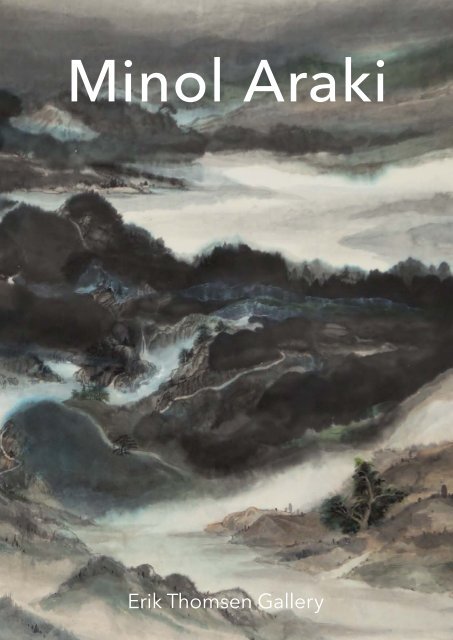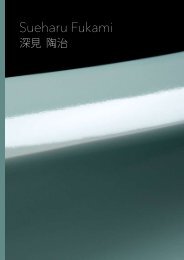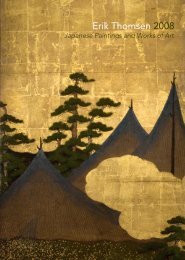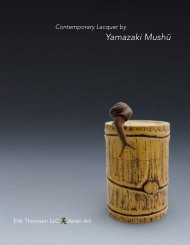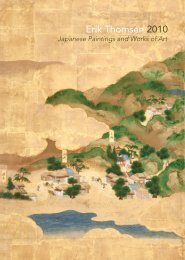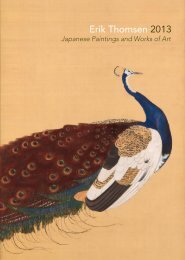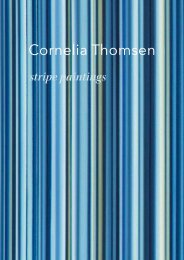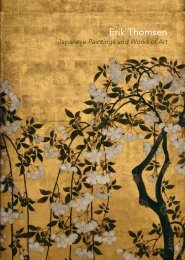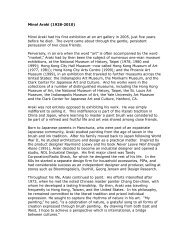Minol Araki - Erik Thomsen
Minol Araki - Erik Thomsen
Minol Araki - Erik Thomsen
Create successful ePaper yourself
Turn your PDF publications into a flip-book with our unique Google optimized e-Paper software.
<strong>Minol</strong> <strong>Araki</strong><br />
<strong>Erik</strong> <strong>Thomsen</strong> Gallery
2<br />
4<br />
46<br />
47<br />
<strong>Minol</strong> <strong>Araki</strong><br />
Table of contents<br />
Foreword<br />
Paintings<br />
Biography<br />
Index<br />
<strong>Erik</strong> <strong>Thomsen</strong> Gallery
Foreword<br />
<strong>Minol</strong> <strong>Araki</strong> (1928 – 2010)<br />
<strong>Minol</strong> <strong>Araki</strong> had his first exhibition at an art gallery<br />
in 2005, just five years before he died. The event<br />
came about through the gentle, persistent persua-<br />
sion of two close friends.<br />
Perversely, in an era when the word »art« is often<br />
accompanied by the word »market,« <strong>Araki</strong> had by<br />
then been the subject of numerous one-man museum<br />
exhibitions, at the National Museum of History,<br />
Taipei (1978, 1980 and 1999); Hong Kong City Hall<br />
Museum—now called Hong Kong Museum of Art<br />
(1977, 1981); Hong Kong City Arts Centre (1999);<br />
and the Phoenix Art Museum (1999), in an exhibition<br />
that traveled to further museums across the United<br />
States: the Indianapolis Art Museum, the Morikami<br />
Museum, and the Clark Center for Japanese Art and<br />
Culture. And his works were in the collections of a<br />
number of distinguished museums, including the<br />
Hong Kong Museum of Art, the National Museum of<br />
History, Taipei, the St. Louis Art Museum, the Indianapolis<br />
Museum of Art, the Yale University Art Museum<br />
and the Clark Center for Japanese Art and<br />
Culture, Hanford, CA.<br />
<strong>Araki</strong> was not entirely opposed to exhibiting his<br />
work. He was simply indifferent to selling it. This indifference<br />
is part of the literati tradition in China<br />
and Japan, where learning to master a paint brush<br />
was considered to be part of a refined and fruitful<br />
life and art was shared among close friends.<br />
Born to Japanese parents in Manchuria, who were<br />
part of an expatriate Japanese community, <strong>Araki</strong><br />
studied painting from the age of seven in the brush<br />
and ink tradition. After his family moved back to<br />
Japan following World War II, he studied architecture<br />
and design as a practical matter. Inspired by<br />
the product designer Raymond Loewy and his book<br />
Never Leave Well Enough Alone (1951), <strong>Araki</strong><br />
decided to become an industrial designer and<br />
opened a studio, NOL Industrial Design. His first<br />
major client was Tandy Corporation/Radio Shack,<br />
for which he designed the rest of his life. In the 60s<br />
he started a separate design firm for household<br />
accessories, PIPa, and had considerable success as<br />
an independent designer and producer, selling<br />
at stores such as Bloomingdale’s, Dunhill, Georg<br />
Jensen and Design Research.<br />
Throughout his life, <strong>Araki</strong> continued to paint. His<br />
efforts intensified after 1973, when he met the noted<br />
Chinese master painter Chang Dai-chien, with whom<br />
he developed a lasting friendship. By then, <strong>Araki</strong><br />
was traveling frequently to Hong Kong, Taiwan, and<br />
the United States. In his philosophy, he remained<br />
committed to the literati tradition and prized individ-<br />
ual expression. He sought to capture the rhythms<br />
of nature in his art. »My painting,« he said, »is a<br />
celebration of nature, a grateful song to all forms<br />
of creation expressed through brush painting. By<br />
drawing from both East and West, I hope to achieve<br />
a perspective which is international, a bridge between<br />
cultures.«<br />
Chinese and Japanese influences are the most<br />
obvious in his works, from craggy mountain peaks,<br />
vistas that extend to far distant horizons, gnarled<br />
pine boughs, lily pads floating on the surface of a<br />
barely suggested pond, dancing ribbons of roads<br />
through mountain passes, nearly abstract fields of<br />
snow that have as a counterpoint finely rendered<br />
shafts of grass, and a breathtaking interplay between<br />
light and shadow.<br />
Yet <strong>Araki</strong> also adopted moments of art of the West,<br />
with bold outlines (Ben Shahn, Charles Burchfield)<br />
and the modal format of oil and canvas paintings.<br />
In two remarkable works in the collection of<br />
the Clark Center for Japanese Art and Culture,<br />
Hekiba Village and The Four Dragons in the Clouds,<br />
<strong>Araki</strong> extended the format of the Japanese screen<br />
to 72 feet in length, spanning 12 panels. <strong>Araki</strong> was<br />
pleased to honor tradition. He was also comfortable<br />
expanding the limits of art as we know it.<br />
Earlier this year, I became the exclusive representative<br />
of <strong>Araki</strong>’s estate. In the years ahead, I look<br />
forward to exhibiting his sublime works in a series of<br />
ongoing exhibitions. For the moment, I am pleased<br />
to present the first New York gallery exhibition of the<br />
work of <strong>Minol</strong> <strong>Araki</strong>.<br />
<strong>Erik</strong> <strong>Thomsen</strong><br />
September 2012<br />
2 3
»Landscape«, 1996, ink and color on paper, H 34 ¾" × W 61 ½" (88.5 × 156 cm)<br />
4
»Hekiba Island«, 1996, ink and color on paper, H 18 ¼" × W 83 ¼" (46.5 × 211.5 cm)<br />
6
»Snowy Mountains«, 1996, ink and color on paper, H 13 ¾" × W 10 ¼" (35 × 26 cm)<br />
8
»Mountain Landscape«, c. 1977, ink and color on paper, H 13 ½" × W 9 ¾" (34 × 25 cm)<br />
10
»Fir Trees«, c. 1977, ink and color on paper, H 18" × W 15 ¼" (46 × 38.5 cm)<br />
12
»Rocky Mountain«, 1976, ink and color on paper, H 53 ¼" × W 26 ¼" (135 × 66.5 cm)<br />
14
»Landscape«, 1981, ink and color on paper, H 18" × W 20 ¾" (45.5 × 53 cm)<br />
16
»Valley Landscape«, c. 1977, ink and color on paper, H 15" × W 18" (38 × 46 cm)<br />
18
»Misty Valley«, c. 1977, ink and color on paper, H 9 ¾" × W 13 ½" (25 × 34 cm)<br />
20
»Fire Island«, 1992, ink and color on paper, H 18" × W 21 ¼" (46 × 54 cm)<br />
22
»Landscape«, 2006, ink and color on paper, H 34 ¾" × W 34 ¾" (88 × 88 cm)<br />
24
»Lotus Pond«, 1991, ink and color on paper, H 34 ¾" × W 69 ¼" (88 × 176 cm)<br />
26
»Lotus Pond«, 1997,<br />
ink on paper,<br />
H 69 ¼" × W 69 ¼"<br />
(176 × 176 cm)<br />
28
»Lotus«, 1996, ink and color on paper, H 27 ¼" × W 54 ¼" (69 × 138 cm)<br />
30
»Lotus«, 2001, ink and color on paper, H 13 ½" × W 27 ¼" (34.5 × 69.4 cm)<br />
32
»Lotus«, 2000, ink and color on paper, H 7 ¾" × W 55 ½" (19.6 × 140.7 cm)<br />
34
»Lotus Pond«, 1977, ink and color on paper, H 27" × W 27" (68.5 × 68.5 cm)<br />
36
»Lotus«, 1977, ink and color on paper, H 18" × W 27" (45.5 × 68.5 cm)<br />
38
»Lotus«, 1993, ink and color on paper, H 37" × W 21" (94 × 53.5 cm)<br />
40
»Plum Branch«, 1977, ink and color on paper, H 13 ½" × W 27" (34.2 × 68.6 cm)<br />
42
»Baixiang Fruit«, 1996, ink and color on paper, H 18" × W 21" (46 × 53.5 cm)<br />
44
Biography<br />
<strong>Minol</strong> <strong>Araki</strong> (1928 – 2010)<br />
1928 Born in Dairen, Manchuria, China, to Japanese parents<br />
1935 Began studying brush painting from a local Chinese painter<br />
1945 Studied architecture at Nanman Kosen in Dairen<br />
1945 Repatriated with his family to Japan, settling in Nagasaki<br />
1947 Resumed studies at Kuwazawa Design School, Tokyo<br />
1959 Started his company NOL Industrial Design in Japan<br />
1960s Extensive travel to Europe, the United States, and Mexico<br />
1960s Started his second company PIPa Corp. in the United States<br />
1973 First met Chang Dai-chien in Taipei<br />
1977 Solo exhibition at Hong Kong City Hall Museum<br />
1978 Solo exhibition at the National Museum of History, Taipei<br />
1980 Solo exhibition at the National Museum of History, Taipei<br />
1981 Solo exhibition at Hong Kong City Hall Museum<br />
1982 Group exhibition »Shigen-ten« at the Tokyo Central Museum<br />
1982 Group exhibition »8. L’Expositions France-Japon«, Paris<br />
1983 Group exhibition »9. L’Expositions France-Japon«, Paris<br />
1999 Solo exhibition at the National Museum of History, Taipei<br />
1999 Solo exhibition at Hong Kong Arts Centre<br />
1999 Solo exhibition at the Phoenix Art Museum, Phoenix, AZ<br />
2001 Group exhibition at the Pacific Asia Museum, Pasadena, CA<br />
2002 Solo exhibition at the Morikami Museum, Delray Beach, FL<br />
2002 Solo exhibition at the Indianapolis Art Museum, Indianapolis, IN<br />
2002 Solo exhibition at the Clark Center for Japanese Art and Culture, Hanford, CA<br />
2005 First gallery exhibition, at the Gerald Peters Gallery, Santa Fe, NM<br />
2007 Second gallery exhibition, at the Gerald Peters Gallery, Santa Fe, NM<br />
2010 Died in Tokyo<br />
46 47<br />
Index<br />
Page Title Date Medium Size Published in <strong>Minol</strong> <strong>Araki</strong>. Claudia<br />
4 Landscape 1996 Ink and color on paper H 34 ¾" × W 61 ½" (88.5 × 156 cm) Item nr. 20<br />
6 Hekiba Island 1996 Ink and color on paper H 18 ¼" × W 83 ¼" (46.5 × 211.5 cm) Item nr. 17<br />
8 Snowy Mountains 1996 Ink and color on paper H 13 ¾" × W 10 ¼" (35 × 26 cm) Item nr. 24<br />
10 Mountain Landscape c. 1977 Ink and color on paper H 13 ½" × W 9 ¾" (34 × 25 cm)<br />
12 Fir Trees c. 1977 Ink and color on paper H 18" × W 15 ¼" (46 × 38.5 cm)<br />
14 Rocky Mountain 1976 Ink and color on paper H 53 ¼" × W 26 ¼" (135 × 66.5 cm)<br />
16 Landscape 1981 Ink and color on paper H 18" × W 20 ¾" (45.5 × 53 cm) Item nr. 5<br />
18 Valley Landscape c. 1977 Ink and color on paper H 15" × W 18" (38 × 46 cm)<br />
20 Misty Valley c. 1977 Ink and color on paper H 9 ¾" × W 13 ½" (25 × 34 cm)<br />
22 Fire Island 1992 Ink and color on paper H 18" × W 21 ¼" (46 × 54 cm) Item nr. 52<br />
24 Landscape 2006 Ink and color on paper H 34 ¾" × W 34 ¾" (88 × 88 cm)<br />
26 Lotus Pond 1991 Ink and color on paper H 34 ¾" × W 69 ¼" (88 × 176 cm) Item nr. 33<br />
28 Lotus Pond 1997 Ink on paper H 69 ¼" × W 69 ¼" (176 × 176 cm) Item nr. 28<br />
30 Lotus 1996 Ink and color on paper H 27 ¼" × W 54 ¼" (69 × 138 cm) Item nr. 30<br />
32 Lotus 2001 Ink and color on paper H 13 ½" × W 27 ¼" (34.5 × 69.4 cm)<br />
34 Lotus 2000 Ink and color on paper H 7 ¾" × W 55 ½" (19.6 × 140.7 cm)<br />
36 Lotus Pond 1977 Ink and color on paper H 27" × W 27" (68.5 × 68.5 cm)<br />
38 Lotus 1977 Ink and color on paper H 18" × W 27" (45.5 × 68.5 cm)<br />
40 Lotus 1993 Ink and color on paper H 37" × W 21" (94 × 53.5 cm) Item nr. 27<br />
42 Plum Branch 1977 Ink and color on paper H 13 ½" × W 27" (34.2 × 68.6 cm)<br />
44 Baixiang Fruit 1996 Ink and color on paper H 18" × W 21" (46 × 53.5 cm) Item nr. 42<br />
Brown, Richard Barnhart, and Steven<br />
Owyoung. Phoenix, 1999
<strong>Erik</strong> <strong>Thomsen</strong> Gallery<br />
Cover: <strong>Minol</strong> <strong>Araki</strong>, »Landscape«, 1996 (page 4)<br />
<strong>Erik</strong> <strong>Thomsen</strong> 2012<br />
<strong>Minol</strong> <strong>Araki</strong><br />
© 2012 <strong>Erik</strong> <strong>Thomsen</strong><br />
Design and Production: Valentin Beinroth<br />
Printed in Germany
<strong>Erik</strong> <strong>Thomsen</strong> Gallery


